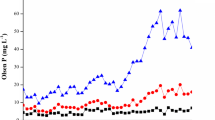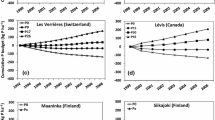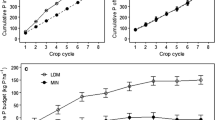Abstract
The general objective of this study was to evaluate the deviation between measured and estimated soil phosphorus (P) content, over 3 years, in a permanent bio-diverse pasture system in Southern Portugal with grazing sheep, and subjected to annual, differential P fertilization. The results can be a contribution to the development of practical and effective site-specific management strategies to minimize pasture yield variation. The soil and pasture samples were taken from a 6 ha field and were geo-referenced with RTK GPS. This procedure was carried out, each year, from March to May, according to the vegetative growth of the pasture. In October of each year the field was fertilized in a differential manner, as a function of soil P concentration measured at the end of the pasture growth cycle (May–June). Maps were developed in ARCGIS 9.3 considering: (1) the soil P concentration and pH; (2) the average P plant uptake; (3) the differential P application; and (4) the extractable P. The significant temporal variability of soil P concentration and pasture dry matter yield confirm the complexity of soil P dynamics in pastures involving two biological systems: plant and animal, under Mediterranean conditions and the consequent difficulties in implementing precision agriculture techniques. The results of this work indicate that 3 years of P variable-rate application rate were not sufficient to obtain homogeneous and adequate levels of P in the whole field for crop production. Despite differential P fertilization with the objective of obtaining homogenous values of soil P content in experimental field, the undulating topography of the experimental field associated with the presence of grazing animals adds a notable short-range spatial variation in nutrients that generally arises from heterogeneous excreta depositions. The small and positive final deviation between measured and estimated P levels suggests the irregular and gradual release of P by the fertilizer over years, contributing to an increase in soil P concentration. P input in fertilizer and removal in the crop greatly exceed all other inputs and outputs. However, the pH effect on extractable P, the estimation of amounts of export/import by livestock, atmospheric deposition or erosion/leaching losses are complex and justify more experiments to evaluate the confidence of long-term estimated P dynamic balance before sustained decision making is possible for differential pasture fertilization and site-specific management strategy implementation.






Similar content being viewed by others
References
Abreu JM, Calouro MF, Soares AMB (1982) Nutrition tables—mediterranean forages cultivated in Portugal. Superior Institute of Agronomy (IST), Technical University of Lisbon (UTL), Portugal (in Portuguese)
Barrow NJ, Carter ED (1978) A modified model for evaluating residual phosphate in soil. Aust J Agric Res 29:1011–1021
Berwanger AL, Ceretta CA, Santos DR (2008) Application of liquid swine manure. Rev Bras Ciência Solo 32:2525–2532 (in Portuguese)
Bolan NS, White RE, Hedley MJ (1990) A review of the use of phosphate rocks as fertilisers for direct application in Australia and New Zealand. Aust J Exp Ag 30:297–313
Cayley J, Quigley P (2005) Phosphorus for sheep and beef pastures. Victorian Government Department of Primary Industries, Vitoria, Australia 4 pp
Cox FR, Kamprath EJ, McCollum RE (1981) A descriptive model of soil test nutrient levels following fertilization. Soil Sci Soc Am J 45:529–532
Daniels MB, Delaune P, Moore PA, Mauromoustakos A, Chapman SL, Langston JM (2001) Soil phosphorus variability in pastures: implications for sampling and environmental management strategies. J Environ Qual 30:2157–2165
Daubeny S (1845) On the distinction between the dormant and active ingredients of the soils. J R Agri Soc England 7:237–245
Efe Serrano J (2006) In: Universidade de Évora- ICAM (ed) Pastures in Alentejo: technical foundations for characterization, grazing and improvement. Gráfica Eborense, Évora, Portugal (in Portuguese), pp 165–178
ESRI (Environmental Systems Research Institute) Inc (2009) ArcView 9.3 GIS Geostatistical Analyst. ESRI, Redlands, CA, USA
FAO (1998) World reference base for soil resources. World soil resources report no 84. Food and Agriculture Organization of the United Nations, Rome, Italy
Gatiboni L, Kaminsku J, Pellegrini J, Brunetto G, Saggin A, Flores J (2000) Influence of phosphorus fertilization and introduction of winter forage species on forage offer from natural pasture. Pesq Agropec Bras 35:1663–1668
Gillingham AG (2001) Precision management of fertiliser application to pasture. In: Proceedings of the first Australian geospatial information and agriculture conference. NSW Agriculture, Sydney, Australia, pp 534–541
Haneklaus S (2006) Site-specific nutrient management: objectives, current status, and future research needs. In: Srinivasan A (ed) Handbook of precision agriculture, principles and applications. Food Products Press, New York, pp 91–270
King J, Dampney P, Lark R, Wheeler H, Bradley R, Mayr T (2005) Mapping potential crop management zones within fields: use of yield-map series and patterns of soil physical properties identified by electromagnetic induction sensing. Prec Agric 6:167–181
Makowski D, Tremblay M, Debroize D, Laurent F (2000) Fertilizer spreaders: vigilance is essential! Perspect Agricoles 263:55 (in French)
Mallarino AP, Wittry DJ (2004) Efficacy of grid and zone soil sampling approaches for site-specific assessment of phosphorus, potassium, pH, and organic matter. Prec Agric 5:131–144
Marques da Silva JR, Peça JO, Serrano JM, Carvalho MJ, Palma PM (2008) Evaluation of spatial and temporal variability of pasture based on topography and the quality of the rainy season. Prec Agric 9:209–229
Martiniello P, D’Agnano G, Piadalino O, Nardelli F (1995) Effect of fertilization on flora, biomass and seed production and soil fertility in four natural pastures of the Mediterranean basin. In: Groupe de Travail Méditerranéen du Réseau Interrégional FAO/CIHEAM de Recherche et Développement sur les Pâturages et les Cultures Fourragères (eds) Sylvopastoral systems. Environmental, agricultural and economic sustainability, Cahiers Options Mediterranéennes. CIHEAM-IAMZ, Zaragoza, Spain, pp 87–90
McCormick S, Jordan C, Bailey J (2009) Within and between-field spatial variation in soil phosphorus in permanent grassland. Prec Agric 10:262–276
Mishima S, Endo A, Kohyama K (2010) Recent trends in phosphate balance nationally and by region in Japan. Nutr Cycl Agroecosyst 86:69–77
Newman EI (1995) Phosphorus inputs to terrestrial ecosystems. J Ecol 83:713–726
Newman EI (1997) Phosphorus balance of contrasting farming systems, past and present. Can food production be sustainable? J Appl Ecol 34:1334–1347
Olsen SR, Cole CV, Watanabe FS, Dean LA (1954) Estimation of available phosphorus in soils by extraction with sodium bicarbonate. Circ. 939. USDA, Washington, DC
Page T, Haygarth PM, Beven KJ, Joynes A, Butler T, Keeler C, Freer J, Owens PN, Wood GA (2005) Spatial variability of soil phosphorus in relation to the topographic index and critical source areas: sampling for assessing risk to water quality. J Environ Qual 34:2263–2277
Quelhas dos Santos J (1976) General aspects of fertilization, 2nd edn. Amoníaco Português S.A.R.L, Lisboa, 147 pp
Rao IM, Barrios E, Amezquita E, Friesen DK, Thomas R, Oberson A, Singh BR (2004) Soil phosphorus dynamics, acquisition and cycling in crop-pasture-fallow systems in low fertility tropical soils: a review from Latin América. In: Delve RJ, Probert ME (eds) ACIAR proceedings, modelling nutrient management in tropical cropping systems. ACIAR, Canberra, Australia, pp 126–134
Rodrigues AM, Cecato U, Fukumoto NM, Galbeiro S, Santos GT, Barbero LM (2008) Concentrations and amounts of macronutrients in the animal dung grazing Panicum maximum fertilized with phosphorous. R Bras Zootécnia 37:990–997 (in Portuguese)
Russell JS (1977) Evaluation of residual nutrients effects in soils. Aust J Agric Res 28:461–475
Sanyal SK, DeDatta SK (1991) Chemistry of phosphorus transformation in soil. Adv Soil Sci 16:1–119
Saroa GS, Biswas CR (1989) A semi-descriptive model for predicting residual-P from fertilizer P applications. Fertilizer Res 19:121–126
Sims JT, Leytem AB, Gartley KL (2002) Interpreting soil phosphorus tests. Department of Plant and Soil Sciences, College of Agriculture and Natural Resources, University of Delaware, Newark, DE 5 pp
Acknowledgments
This study was sponsored by the AGRO, Programme of the Ministry of Agriculture of Portugal (project AGRO390).
Author information
Authors and Affiliations
Corresponding author
Rights and permissions
About this article
Cite this article
Serrano, J.M., Peça, J.O., Marques da Silva, J.R. et al. Phosphorus dynamics in permanent pastures: differential fertilizing and the animal effect. Nutr Cycl Agroecosyst 90, 63–74 (2011). https://doi.org/10.1007/s10705-010-9412-2
Received:
Accepted:
Published:
Issue Date:
DOI: https://doi.org/10.1007/s10705-010-9412-2




